- Home›
- Pharmaceuticals›
- Injections›
- Small Volume Injections›
- Amikacin Injection
Amikacin Injection
Dosage
Packaging
What is Amikacin?
Active Ingredients: Amikacin Sulfate
Amikacin Injection is an antibiotic drug used for the short-term treatment of serious bacterial infections. This drug is effective against bacterial septicemia, including neonatal sepsis. It is also indicated to treat infections in the respiratory tract, central nervous system, abdomen, and bones or joints.
Amikacin Injection may be used to treat infections associated with burns or surgery. It is also prescribed with other medications to treat tuberculosis.
Amikacin is classified as an aminoglycoside antibiotic. It is a semi-synthetic aminoglycoside antibiotic that is derived from kanamycin A. It works by blocking protein synthesis, which stops bacterial growth. This drug shows action against gram-negative bacteria, including Escherichia coli, Klebsiella-Enterobacter-Serratia, and Acinetobacter.
Functioning as a broad-spectrum antibiotic, it inhibits bacterial protein synthesis, resulting in the termination of bacterial cells and hindrance of new cell growth. It is effective against a wide range of gram-positive and gram-negative bacteria.
Upon entering the human body, bacteria replicate through protein synthesis facilitated by ribosomal proteins. Amikacin binds to the bacterial 30S ribosomal subunit, inhibiting bacterial replication. This binding to bacterial ribosomes contributes to its broad-spectrum antibacterial activity.
This antibiotic is rapidly absorbed after intramuscular administration. There is also a rapid absorption occurs from the peritoneum and pleura. When administered intravenously, the peak concentrations of the drug average 38 micrograms/mL immediately following the infusion, 5.5 micrograms/mL at 4 hours, and 1.3 micrograms/mL at 8 hours. The bioavailability of this drug varies due to the individual differences in nebulizer efficiency and airway pathology. Amikacin can be found in bone, heart, gallbladder, and lung tissue, and it is also distributed into bile, sputum, bronchial secretions, and interstitial, pleural, and synovial fluids.
Amikacin has structural modifications to minimize potential enzymatic deactivation routes, which reduces bacterial resistance. Studies show that many Gram-negative organisms resistant to gentamicin and tobramycin are sensitive to amikacin.
The elimination of the drug is through the kidneys. In adults with normal renal function, most of the drug Amikacin is excreted unchanged through glomerular filtration within 24 hours. In individuals with normal, healthy renal function, complete recovery of amikacin is achieved within approximately 10-20 days. In cases of altered renal function, the clearance of amikacin is reduced, with a slower clearance rate depending on the severity of the impairment. The dosing interval of amikacin should depend on the degree of renal impairment. Parameters such as endogenous creatinine clearance rate and serum creatinine, which exhibit a strong correlation with the serum half-life of amikacin, can serve as guides for dosage adjustments. Typically, the plasma elimination half-life of amikacin ranges from 2 to 3 hours in adults with normal renal function. However, in adults with severe renal impairment, the half-life is reported to extend from 30-86 hours.
AdvaCare Pharma is a global supplier of Amikacin Injections. AdvaCare excels at the production of high-quality yet cost-effective medical treatments. This medicine has been manufactured in our GMP-certified facilities located in China, India, and the USA.
Why are we a leading Amikacin manufacturer?
AdvaCare Pharma, a US-owned pharmaceutical company, is a manufacturer of Amikacin Injection with GMP-compliant manufacturing facilities located worldwide. We conduct frequent GMP, third-party and internal facility inspections to ensure that our manufactured injectable treatments exceed the stringent requirements of importing countries and our distributors.
As a renown Amikacin manufacturer and global supplier of 120+ pharmaceutical injection products, our global reach extends to over 65 markets ensuring that pharmaceutical distributors, hospitals, pharmacies, NGOs and government institutions receive the quality-assured treatments they need.
Uses
What is Amikacin used for?
It is used for the short-term treatment of serious bacterial infections, such as meningitis or infections of the blood, abdomen, lungs, skin, and other parts of the body.
How are Amikacin Injections given?
This medication is manufactured as a solution. It should be injected intravenously or intramuscularly every 8 or 12 hours.
What dose should be given?
The typical dosage is 15mg/kg/day, given every 8 to 12 hours.
Refer to a doctor or pharmacist for guidelines on dosage. Do not exceed what they advise.
Why is Amikacin used in humans?
This drug is used for the short-term treatment of serious infections due to susceptible strains of Gram-negative bacteria, including Pseudomonas species, Escherichia coli, species of indole-positive and indole-negative Proteus, Providencia species, Klebsiella species, Enterobacter species, Serratia species, and Acinetobacter species. To reduce antibiotic resistance, this drug should be used only for treating or preventing infections that are susceptible to this antibiotic.
Can Amikacin Injection be given to pregnant women?
Amikacin, like the other aminoglycosides, can lead to fetal harm in pregnant women because it crosses the mother’s placenta. It can lead to total irreversible, bilateral congenital deafness in children. If the patient becomes pregnant during Amikacin treatment, she should be aware of the potential side effects on the fetus.
Can this drug be administered to older patients?
Yes, this drug can be administered to older patients if they have normal renal function. If not, the dose should be adjusted. The renal function of older patients should be monitored.
Can this drug be administered to pediatric patients?
It depends; this drug should be used with caution in the pediatric population because of the renal immaturity of the patients, which leads to serum half-life prolongation.
What happens in cases of overdose?
In cases of Amikacin overdose, peritoneal dialysis or hemodialysis are recommended. In infants, an exchange transfusion might help.
Other warnings
The renal function of the patients treated with Amikacin should be monitored, and this drug should be used with caution in patients with muscular disorders.
A combination of this drug and beta-lactam antibiotics can lead to drug inactivation.
Other antibiotics, and also this one, might lead to overgrowth of nonsusceptible organisms. This drug should not be given with potent diuretics.
There might be a chance for nephrotoxic, ototoxic, and neurotoxic side effects of this antibiotic. Mild cochlear damage is also possible.
Clostridium difficile associated diarrhea might occur due to the Amikacin administration. It should be treated symptomatically.
Side Effects
As with all pharmaceuticals, some unwanted effects can occur from the use of Amikacin Injection.
Common side effects include, but may not be limited to:
- nausea or vomiting
- loss of appetite
- pain or irritation at the site of injection
Serious side effects may include:
- numbness or tingling
- weakness
- seizures
- persistent diarrhea or bloody stools
- signs of an allergic reaction
Some patients might have serious kidney problems. This is especially the case in older patients or dehydrated individuals. The most common kidney problems are:
- decreased urination
- swelling (arms, face, feet, hands, ankles, and lower legs)
- unusual tiredness
- weakness
If any of these signs are noticed, they should be reported to doctors immediately.
This antibiotic can lead to serious hearing problems, especially in older patients who are dehydrated. This is a serious sign because it can lead to permanent hearing damage. You should inform your doctor if you have a history of hearing loss due to any other medication. If you notice roaring or ringing in the ears, immediately stop the treatment process and contact your doctor.
This drug can also lead to CNS problems like burning, numbness, tingling, muscle twitching, weakness, or seizures.
For a comprehensive understanding of all potential side effects, consult a medical professional.
If any symptoms persist or worsen, or you notice any other symptoms, please call your doctor.
Precautions
Do not have an Amikacin Injection if:
- You are allergic to amikacin or any of the other ingredients.
- You are allergic to any other aminoglycoside antibiotics.
Before treatment, consult your doctor regarding any medications you are taking to address potential drug interactions.If some adverse reactions are noticed after the Amikacin initial dose, they should be reported to a doctor or pharmacist.
This medication may not be suitable for people with certain conditions, so it is important to consult with a doctor if you have any health conditions.
If patients skip a dose, they should not take double doses. They should proceed to the next scheduled dose.
If patients do not feel improvement during the first days of the treatment process, they should inform their doctor. There are chances that the bacteria is resistant to this antibiotic, and that is the reason why antibiogram testing is needed.
The drug should be consumed until the whole dosage is taken, even if the patient has a significant improvement. Stopping the treatment process with antibiotics might lead to adverse effects, and patients might develop antibiotic resistance due to the untreated condition.
Patients should inform their doctors if they are breastfeeding, pregnant, or planning to stay pregnant.
All appointments should be kept with the doctor and the laboratory. Certain tests, including hearing assessments, will be ordered by doctors before and during treatment to assess the patient’s response to amikacin.
Patients should inform their doctors if they are allergic to Amikacin injections or similar aminoglycoside drugs like gentamicin, kanamycin, neomycin, plazomicin, streptomycin, or tobramycin; sulfites; any other medications; or any of the ingredients in amikacin injection. It is advisable to inform the doctors about any prescription or nonprescription medications.
During the treatment with Amikacin, patients should not consume alcohol.
This drug should be kept out of reach of children.
References
The comparative effects of erythromycin and amikacin on acute respiratory Pseudomonas aeruginosa infection
Pseudomonas aeruginosa (P. aeruginosa) is a common cause of pneumonia and this bacterium tends to develop resistance to various antibiotics. Amikacin and erythromycin are antibiotics from the aminoglycoside and macrolide antibiotic families and are used to treat respiratory infections caused by P. aeruginosa.
The main goal of this study was to examine whether amikacin, erythromycin or a combination of both works better against P. aeruginosa acute lung infection.
This is an animal study in which 32 rats were used. The rats received amikacin, erythromycin, or a combination of both for 1 week. During the study macroscopic and microscopic evaluations of the lungs, kidney, and liver were performed and the right lung was collected for in vivo bacteriological analysis.
The amikacin group (A group) had statistically significantly lower macroscopic and microscopic scores than the other groups (p < 0.05) and it also had a lower lung bacterial load (p < 0.05).
The conclusion of this study is that amikacin could help alleviate the respiratory infection caused by P. aeruginosa alone, and it was more effective than erythromycin.

You might be interested in...
Why AdvaCare Pharma?
As an industry leader, we are aware of our responsibility to provide affordable and sustainable solutions to improve healthcare worldwide.













